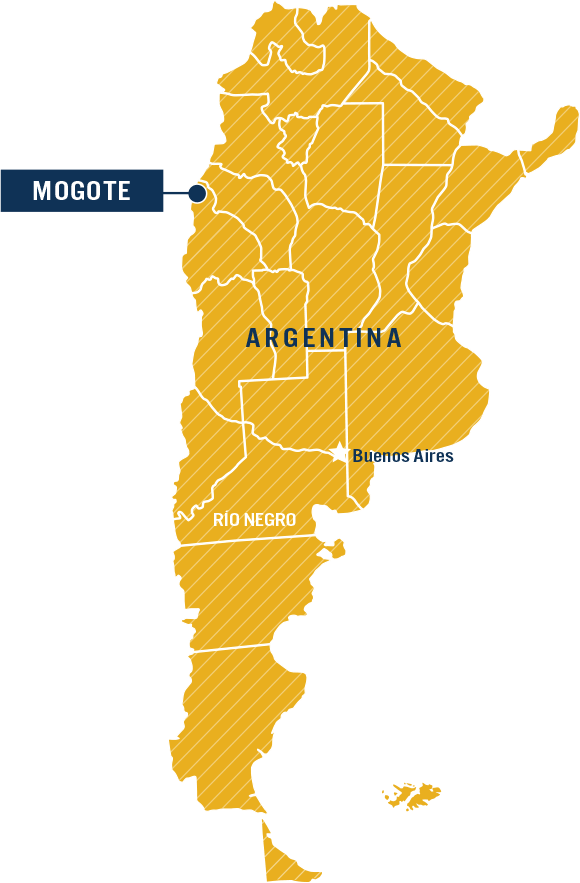Property & Access
Mogote is located 350 kilometres northwest of San Juan City, San Juan province, Argentina and adjoins the international border between Chile and Argentina. Access to the property is possible from either Chile or Argentina, but practical access is currently from the Argentina side. The property is located in moderate to steep mountainous terrain on the upper eastern slopes of the Andean Cordillera, with elevations ranging from 4,300 to 5,500 metres above sea level.
Geology & Exploration Summary
[For full details of exploration results, please refer to the original News Releases filed on SEDAR.]
Regional Geology
This Mogote project is situated in the southern extension of the Maricunga Gold-Copper Belt, in an area also considered to be the geologic bridge to the El Indio Gold Belt to the south, with both districts hosting world-class porphyry and epithermal deposits that provide models for exploration in the region. Locally, the Mogote project is adjacent to the Filo del Sol property, where the main copper/gold porphyry system is located two kilometres to the north. Filo del Sol hosts reported proven and probable reserves of 2,220 Mlbs copper and 2,867 koz gold (259.6Mt @ 0.39% Cu & 0.34 g/t Au, www.filo-mining.com 12/16/24) [Golden Arrow cautions that proximity to a mineral resource, deposit, or mine does not indicate that mineralization will occur on Golden Arrow’s property, and if mineralization does occur, that it will occur in sufficient quantity or grade that would result in an economic extraction scenario. Note that Golden Arrow’s Qualified Person has been unable to verify the above reserve information.]
Mogote lies within a regional belt of hydrothermally altered rocks referred to as the 'Faja de Potro'. Alteration is related to high-level intrusions and subvolcanic hydrothermal activity, with potential for porphyry copper-gold, as well as precious metal epithermal deposits. The region is underlain by extensive volcanic units and related intrusive bodies of the Middle Miocene and older, making the area particularly attractive for mineral exploration. Regional mapping indicates that the Mogote project area is underlain by Oligocene - Early to Middle Miocene age volcanic rocks of the Penas Negras and Dona Ana Formations.
Property Geology and Mineralization
The property is underlain by basement rocks of the Permian age Choiyoi Group, which are faulted against and overlain by Tertiary age volcanic rocks. Alteration at Mogote is characterized by early porphyry style alteration with a later epithermal alteration overprint. There are three distinct porphyry centers at Mogote, related to a ~15Ma diorite porphyry system: Filo Este, Filo Central, and Zona Colorida.
The dominant alteration associated with mineralization is a potassic assemblage of biotite, magnetite, quartz, and potassium feldspar. Mineralization is also found associated with propylitic alteration consisting of chlorite, quartz, magnetite, and calcite. This alteration is hosted in microdiorite, fine-grained diorite, and Tilito breccias, and the grade of hypogene mineralization is largely a function of quartz vein density. Quartz veins consist of 2-10 millimetre wide A-type veins that are continuous over several meters of length and are generally stockwork in nature. A-type quartz veins are 1-10 millimeter veins of magmatic/hydrothermal quartz with disseminated magnetite, biotite, chalcopyrite, pyrite, and bornite. They generally form stockworks, but locally are sheeted and range in density from one per metre to four per centimetre. Hypogene sulfide mineralization consists largely of chalcopyrite, bornite, and pyrite with local hypogene alteration of copper sulfides to digenite, chalcocite, and covellite. Surface oxidation of chalcopyrite, bornite, and pyrite has resulted in various sulfates, carbonates, and iron oxides that include antlerite, brochantite, malachite, azurite, goethite, hematite, and jarosite.
Overprinting the potassic alteration is weak to moderate anhydrite-carbonate veins that are commonly oxidized to gypsum within the zone of surface oxidation.
Golden Arrow identified several large target areas with anomalous gold and copper through a combination of surface sampling, trenching, ground magnetic surveying and drill testing.
The project was optioned in May of 2022 and is now being operated as part of Mogotes Metals Inc’s Filo Sur project. Details and status of the earn-in are available in the latest MDA.
